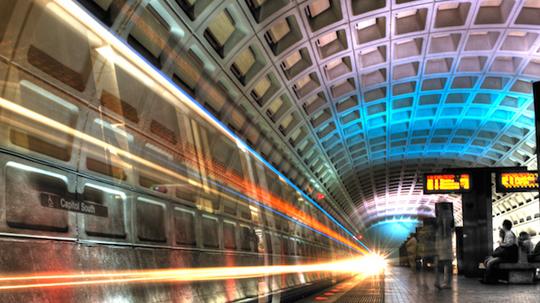
"You have to be kidding me, there's no more trains tonight?"
Megan and her three friends stared incredulously at the shuttered entrance of the Farragut West Metro station. The four women had assumed 12:45 a.m. that Sunday morning would be plenty early to catch the Metro back to their apartment complex in Clarendon. But they had forgotten that Metro's SafeTrack program had begun over the weekend, changing the weekend closing time for Metro from 3 a.m. to midnight for the foreseeable future.
"I had heard about it. I just didn't realize it started already. This is really annoying," Megan told me.
The 24-year-old economist moved to D.C. in April from North Carolina, and said she relied on Metro's late weekends to make it possible to go out in the District and still get home.
"I think I've taken the Metro after midnight every Saturday since I moved," she said. "I guess I'll have to figure something else out."
TheSafeTrack program allows WMATA to do three years-worth of repairs and maintenance in just ten months, but there's no question that the D.C. area and its residents are having to rethink their travel routines. The weekend schedule changes are just the beginning. This week, single tracking began on part of the Orange and Silver Lines, with closings on the Silver and Blue Lines beginning June 18. The schedule of closures and other Metro alterations isn't finalized yet, but the shutdowns will likely start hitting more central parts of the Metro at the end of summer.
"Of course I'm irritated, but it's better than a fire," Michael, a 27-year-old lawyer from Ohio, told DC Inno Monday evening around 7 p.m. at the Ballston Metro station. He said he'd been waiting at least 20 minutes for an Orange Line train out to Vienna, compared to the five minutes he usually had to wait. "I've already started planning a carpool with some co-workers, but I really don't want to think about what the traffic will be like."
How D.C. will cope - D.C. Mayor Muriel Bowser made sure to get out ahead of the changes, announcing plans to alter traffic signal timing, add more traffic control officers and change up rush hour parking restrictions. Significant outcomes from these relatively minor changes could make the difference between a slightly longer commute and a hellish nightmare of road rage and exhaust fumes.
Capital Bikeshare meanwhile rolled out a pilot program this week offering one-time bike rentals for $2, a temptation for the occasional bike user who doesn't want to pay $7 for an all-day pass. Even its first day saw a bump of a couple thousand more bikeshare users than usual according to a Capital Bikeshare spokesperson, and there's every reason to think that number will grow as more people learn about it. And judging by some of the social media response on Monday, bikes will be really popular for Metro users fed up with long waits.
Today is the last day I attempt to use the DC metro. It is unreliable and expensive. 38 mins by bike to DC and 67 mins by metro. Ridiculous.
— DJ Neekola (@DJNeekola) June 6, 2016
Uber and Lyft heat up - Megan and her friends almost immediately reached for their phones when they saw the closed Metro station. One opened up Uber while Megan tried Lyft to see if there was a difference in cost.
"I'll probably be doing this a lot more," she said. "My bank account is not going to be happy."
The boom in ride-hailing apps and sharing services like Uber, Lyft, Split and others in D.C. over the last couple of years arguably makes the SafeTrack program more feasible than it might have been otherwise. Uber and Lyft have been upping the amount of money and attention they pay to the region, and have made a point of keeping potential D.C. riders and drivers apprised of how they will respond this summer.
"We've put an enormous amount of effort, thought and attention [into] how the transportation ecosystem would be affected and how to respond," Uber East Coast General Manager Meghan Joyce told DC Inno in an interview this week. "[The SafeTrack program is] relatively unprecedented. [We] want to do our part to help the region get around."
Uber has been pushing its UberPool program in particular, extending it from the District to the entire D.C. region during the course of the program. And UberPool drew in a notably higher number of users on Monday morning according to Joyce and her team. Uber is keeping a close watch on how the closings are scheduled so as to keep drivers in the loop on where a lot of riders can be found.
"[Uber is] furthering the idea of carpooling," Joyce said. "We have the tools and tech to do that seamlessly."
Lyft meanwhile has put millions of dollars into growing its presences in D.C. this year, with a new advertising blitz and a physical office in the area for the first time. The company is aiming to leverage the Metro shutdowns to draw in more users, and is slashing its Lyft Line carpooling service prices by 75 percent during commuting hours in the morning and evening, among other discounts, as a way to get people to try and perhaps stick with its service.
"What makes a transportation ecosystem work is options."
"We're going all in for D.C.," Lyft's D.C. General Manager Steve Taylor told DC Inno. "We've put $15 million into D.C. over the last year, growing our driver base, growing demand. We have a lot of rides starting or ending at Metro stations already. I think we'll see even more with what's going on with Metro."
D.C.-based ride-share service Split isn't lying down on the Metro changes either. Split doesn't do surge pricing anyway, but has taken steps like improving the app's software, offering ride discounts to new users and giving a dollar credit for every ride taken by a Split user in June.
Of course, sometimes the actual driver has more than one ball in the air. The sedan that pulled up for Megan and her friends a few minutes after they requested it had both Uber and Lyft stickers. Only the glowing pink screen on Megan's phone revealed that the group had decided to use Lyft because of a lower price multiple.
Get behind the wheel - "I don't really like using Uber-type apps," Jonathan, a 31-year-old accountant told me while he waited at the Ballston station on Monday. "I'd rather drive myself." Jonathan admitted he hasn't owned a car for over a year now, relying on short-term rental service car2go when he needs a vehicle.
That's an option that recently got a lot more convenient. Instead of having to end your car2go trip in the same city you started, Arlington and D.C. reached an agreement to let car2go drivers start in one jurisdiction and end in the other, a coincidental but entirely salient feature this summer.
"Yeah, I heard about [car2go's news] but I haven't tried it yet. I usually am just using it in D.C.," Jonathan said. "It's a good idea."
While car2go and Zipcar have their own fleets of cars, peer-to-peer car rental platform Getaround now has nearly 100 cars owned by locals looking to make some money by renting their own cars to people. Ranging from Teslas at $50 an hour to 2011 Nissan's at $8 an hour, it's another option for at least occasional rentals, and one likely to see a lot more use before the weather cools this fall.
Metro's metamorphosis - Even if everything goes smoothly with the SafeTrack program, the transportation environment in D.C. may not be the same. Riders may get used to different ways of getting around, or not entirely trust Metro after almost a year of various disruptions. Metro may have a new schedule permanently in place, with no late-night weekend schedules at all, much as Boston got rid of its own late night transit service after a multi-year trial period proved financially unsustainable. And there may even be new companies or new city programs that grow during SafeTrack to augment the list of ways people get where they want to go.
"The appetite for good ideas is endless," Joyce said. "What makes a transportation ecosystem work is options."
"I think I'll try the bikes next time," Megan said. "I just have to remember to bring flats."
Check out the interactive map of transport options put together by the District Department of Transportation below for more information on ways to travel during SafeTrack.




